The Land Of China -- Explore by Province
Hebei
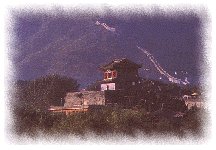 Hebei
Hebei
|
Hebei is located in the North China Plain bordering the Bohai Sea in the east. Covering an area of 187,700 square kilometers, the climate is Continental in the temperate zones. With a population of 63,877,100, the people living their are Han, Muslim, Mongolian and Manchurian. It contains ten cities, including Shijiazhuang, Qinhuangdao, and Chengde, and 139 counties.
There are many well-known sights of interest throughout the province that is backed with mountains bordering the sea. It covers a great variety of topographies and land forms, such as plateaus, mountains, plains, lakes, and coastal areas. Near the eastern suburbs of Beijing there are the East and West Mausoleums of the Qing Dynasty; the Qinhuangdao, the Nandaihe & Beidaihe Resorts, the Shanghai Pass in the east; the Chengde Summer Resort in the north; the Baiyangdian Scenic Area in the center; and the Pilu Temple, the Bridge of Zhao County, and Cangyan Mountain near the capital, Shijiazhuang, in the south.
Capital city, Shijiazhuang (Village of the Shi's), is 4 hours by train south of Beijing. It is an important center of the railway system and also played an important role in China's revolutionary history. It is the burial place of Canadian Dr. Norman Bethune, who was honored as a Chinese hero for helping the Chinese army in its fight against the Japanese in 1938. He died in 1939 and was buried in the North China Revolutionary Martyr's Cemetary. Shijiazhuang is also known for the Zhaozhou Bridge, a bridge built between 605 and 610 A.D.
Qinhuangdao (the Qin Emperor's Island) is on the northeastern tip of Hebei on the Bohai Sea and is one of China's busiest harbors. The city is named after a legend that describes how the Qin Emperor found pills of longevity in the city. Visitors can walk along the waterfront and watch fishing boats or visit the shell-carving factory and the Qin Emperor's Temple.
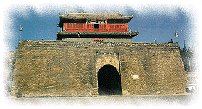 the Shanhai Pass
the Shanhai Pass
|
Built in 1381, the Shanhai Pass is a national tourist attraction and the first strategic pass at the eastern terminus of the Great Wall. Shanhai Pass, 15 kilometers from the tourist city of Qinhuangdao, is so-called because it is situated between the Yanshan Mountains and the Bohai Sea. As the strategic passage between North and Northeast China, the pass has always been a bone of contention for military strategists since the ancient times. On the eastern city tower hangs a huge plaque bearing the horizontal inscription of five Chinese characters in bold script, meaning the "Pass under Heaven." The magnificent city tower, the almost inaccessible terrain, and the calligraphic art of the inscription are regarded as three unique aspects of the Shanhai Pass.
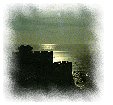 Laolongtou
Laolongtou
|
Laolongtou (Old Dragon Head) is a national tourist attraction that is situated four kilometers south of Shanhai Pass. Washed by the Bohai Sea, it was the eastern end of the Great Wall during the Ming Dynasty. Built in 1381, it was the Ninghai Stone City being a half kilometer in diameter and jutting 23 meters into the sea with the Chenghai Tower standing on the city wall. Later, it was destroyed in the havoc of war and today, only broken walls remain. Fortunately, the stone city and the tower was restored in 1985 during the national campaign of renovating the Great Wall.
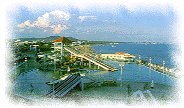 Beidaihe Beach
Beidaihe Beach
|
Situated 15 kilometers southwest of Qinhuangdao, Beidaihe Beach is a nationally recognized scenic attraction of China. Washed continiously by the Bohai Sea, the beach is two kilometers wide and 10 kilometers long with the bay winding along. Being a gentle beach, Beidaihe is ideal for sea baths in the steamy heat. As far back as 1898, the Qing government officially turned the beach into a summer resort. Since 1949, when New China was founded, over 3,000 restaurants, shops, hotels, and guesthouses have been built on Beidaihe Beach, making it one of the most famous tourist attractions in North China.
As China's largest and best-preserved imperial tomb complex, the Eastern Imperial Tombs are located at the southern foot of the Changruishan Mountain in Zunhua County, 125 km from Beijing. Construction began in 1663 in the 48-square-km area where 15 tombs of five emperors, 14 empresses and 136 imperial concubines lay. Empress Dowager Cixi's tomb is the most luxurious of all. Its Long'en (Great Benevolence) Hall is decorated with sculptured white marble. And leading to her tomb is a flight of stone steps carved with dragons and phoenixes. The underground palace was built of white marble. Inside the complex are not only many coffin chambers but also more than 1,000 palace halls, tablet towers and stone elephants together with an excellent collection of stone-carved art treasures.
Chengde and its Imperial Resort
Chengde is situated in northeastern Hebei, 220 kilometers from Beijing. Throughout the Ming Dynasty and the first part of the Qing Dynasty, the city was known as Rehe Shangying and became the base for the activities of the Qing Dynasty government.
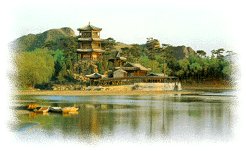 Chengde: the Resort
Chengde: the Resort
|
During the reign of Emperor Yongzheng (1723-1735), in order to furnish the wishes of Emperor Kangxi, it was renamed as Chengde.
Chengde is 300 meters above sea level in a valley . It is surrounded by nature and, being cool, it is an ideal place to which to escape in the summer. The city therefore is putting a lot of work into promoting the city as a tourist spot. As it is home to many of China's national historic treasures - the Imperial Mountain Resort and the Temple Park - it has been designated as one of UNESCO's world cultural heritage areas.
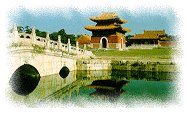 Inside Chengde
Inside Chengde
|
Tucked away in a hill-encircled basin 155 miles northeast of Beijing, the mountain resort at Chengde, formerly known as the Jehol Summer Palace, is one of the biggest and most celebrated former imperial gardens in China.
Opened in recent years to foreign tourists, the imperial garden is far less well-known than Beijing's Forbidden City or Summer Palace, despite the fact that it is bigger than both of them combined--5.64 million square meters to be precise. The imperial summer resort is the world's largest imperial garden and boasts 120 terraces, pavilions, and towers that are characteristic of gardening architecture. Seventy-two scenic spots in the imperial garden bear inscriptions by Emperors Kangxi and Qianlong. In the resort there also is a well furnished Mongolian Yurt hotel, where accommodation will add much to the novelty of a sightseeing tour.
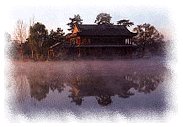 Mist and Rain at Chengde
Mist and Rain at Chengde
|
It is Chengde's natural beauty and pleasantly cool climate even at the height of summer that caught the fancy of the second emperor of the Qing Dynasty, Kangxi, when he toured the region in the early days of his reign.
Park-laying and palace construction started in 1703, and the resort reached its present dimensions in 1790. With four clusters of magnificent halls, palaces and pavilions nesting among the wooed slops inside a meandering, six-mile, red-painted wall,
 Putuozhongcheng
Putuozhongcheng
|
the area is a superb blend of traditional architecture and landscape gardening, mixing the courtyard styles typical of north China with the soft, misty landscapes of the south. Qing emperors regularly spent several summer months at the resort, and it was there that Emperor Qian Long received an emissary from England---the first Western envoy to visit the Qing court.
To the north and east outside the palace wall are the "Eight Outer Temples," built to celebrate birthdays of emperors and their mothers. Their glistening tiles and grand construction show a harmonic combination of the Han, Mongolian, and Tibetan architectural style. Among these is the Puning Temple (the Temple of the Universal Palace), a replica of the Sanmoya Temple of Tibet; Dacheng Ge (the Big Buddha Temple); the Putuozhongcheng Temple, a replica of the Potala Palace in Tibet; the Pule Temple; and the Xumi Fushou Temple. The 'Thousand Hands and Thousand Eyes of Avalokitesvara' in the Puning monastery is the largest carved wooden statue of Buddha in the world, standing 70 feet tall. The mountain resort together with the majestic temples provide a miniature version that shows the gloriousness of the land of China.



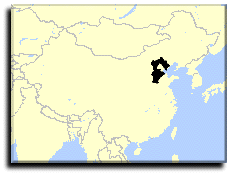












 Chinese Culture
Chinese Culture